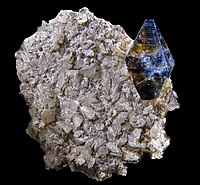
Photo from wikipedia
TiO2 samples with different ratios of anatase/rutile phases were synthesized via a microwave assisted sol–gel method and by applying particular concentrations of titanium(IV) isopropoxide as a single source precursor (SSP)… Click to show full abstract
TiO2 samples with different ratios of anatase/rutile phases were synthesized via a microwave assisted sol–gel method and by applying particular concentrations of titanium(IV) isopropoxide as a single source precursor (SSP) with a constant concentration of nitric acid, which was used as the structure directing agent. The effect of the TiO2 composition ratio of anatase to rutile on the physicochemical and photocatalytic properties was studied. The structural, morphological, and optical properties of the as-prepared samples were studied via X-ray diffraction (XRD), high-resolution transmission electron microscopy (HRTEM), and UV-Vis diffuse reflectance spectroscopy (DRS), respectively. In addition, the functional groups were determined via Fourier transform infrared (FTIR) spectroscopy. The characterization results showed that the crystallite sizes were in the range of 30–70 nm and also revealed the different crystalline phase ratios of anatase and rutile depending on the concentrations of the Ti precursor. The photocatalytic degradation of the as-synthesized samples was evaluated with crystal violet (CV) and methylene blue (MB) solutions under UV light irradiation. The results confirmed that the TiO2 sample containing 81.65 wt% anatase exhibited a high photoactivity of organic dye degradation. The inhibitory effects of the as-synthesized samples of TiO2 nanoparticles were determined against different multidrug resistant Gram-positive and negative bacterial pathogens. The most active sample was the one with the highest ratio of anatase to rutile.
Journal Title: New Journal of Chemistry
Year Published: 2020
Link to full text (if available)
Share on Social Media: Sign Up to like & get
recommendations!